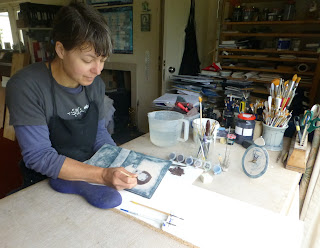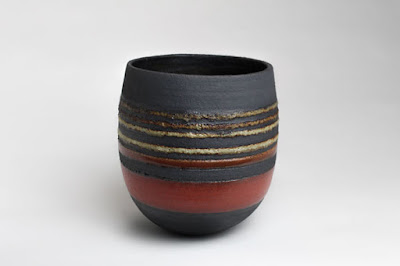Autumn 2015 At Contemporary Ceramics Centre - Featured Makers
Continuing with our focus on new makers to the gallery, this Autumn we are featuring 8 artists. This is an insight into their work, making practice and thought processes.
We are continuing the theme of asking makers to tell us something about the different routes they took when they first began working with clay. Over the last few years many ceramics courses have closed or face closure across the U.K. Ever resourceful, those who work with clay find new ways to train and be trained and it is interesting to see the many different routes taken. Whether through formal education, mid career change in direction or at a young age, these are interesting stories.
Stories that will hopefully inspire others.
WENDY KERSHAW - The positive impact of residencies
Wendy Kershaw was directly affected by the closure of colleges - loosing her job as a ceramics technician at the Glasgow School of Art when the last ceramics department in Scotland was closed. Wendy studied formally through a degree and then a Masters and was able to develop her work as artist in residence in schools.
 | |||||
| Wendy Kershaw in her studio |
'I always enjoyed drawing and making things as a child, even digging clay out of the garden to make things. At first unable to get in to art school I became a community arts worker, and
completed a diploma in art and design, specializing in ceramics. This was a big help as I learned how to throw, and learned a lot about clay before my degree at Grays School of Art, Aberdeen, then went straight on to the Masters degree at Cardiff, which was a wonderful, vibrant and rigorous course.
 |
| Wendy Kershaw detail Hydrangea Girl |
When I no longer had my workspace at the Glasgow School of Art I moved to the Glasgow Ceramic Studio, a great communal studio, with good facilities. This kept me going till my partner and I moved to an old farm house with a couple of acres, high up in a Scottish glen. So now I’m delighted to be a full time maker, with two kilns in the barn, and a home studio with wonderful views.
 |
| Wendy Kershaw detail Catch |
 |
| Wendy Kershaw - Love Garlands |
 |
| Wendy Kershaw - Maud |
CHRISTINE GITTINS - A FUTURE SHAPED BY CLAY
Christine Gittins was first introduced to pottery through evening classes in South Africa during the 1980's and she is still fascinated with the 'magic of clay'. Memories of her formative years in Africa inspire her work... "Inspiration comes from my love for classical concepts of beauty, continuous links to my African roots and the pure joy of clay as a medium of expression"

Christine Gittins in her studio
"I have been throwing pots on the potter’s wheel since starting out a career in ceramics in South Africa in the 1980’s. The simplicity or complexity of shapes that can be created on the potter’s wheel has constantly challenged me to explore and refine this technique further.
My introduction to pottery was through evening classes, and I immediately knew that my future would be shaped by clay. The magic of clay turning into beautiful objects is still as fascinating to me as it was when I first experienced it. I set up a workshop in my garage and had my first solo exhibition two years later. By the time the opportunity came to move to the UK, I was established as a potter and was also running a successful art and ceramic gallery. I saw my move to the UK as an opportunity to work in a new and stimulating environment. It certainly was!
 |
| Christine Gittins |
I moved to the UK and settled in Wales in 1994. My studio is in a Craft Centre where I enjoy and benefit from the interaction with other craft makers. Moving from Africa to Britain had a profound effect on my life. Memories of my formative years became inspiration for a new work with distinct African roots.
My work consists of traditional shapes presented in a contemporary style. I throw all my work but very often alter the pieces. I am mainly interested in form as opposed to function. The refined finish that can be achieved by turning and burnishing is a perfect vehicle for the effects of primitive firings that reacts to fire and heat on the bare clay surface
I use a variety of firing techniques for my work. Saggarfirings with salt, copper and sawdust give subtle hues of colour to the burnished surfaces of the vessels. I also work with black and white horsehair and feather-carbonization and often combine different techniques through multiple firings. I have also started using metal sulphates recently and in particular cobalt to achieve shades of blue and grey.

Inspiration comes from my love for classical concepts of beauty, continuous links to my African roots and the pure joy of clay as a medium of expression."
ROSALIE DODDS - helped by the Open House movement
Rosalie Dodds first experienced working with clay as a mature student when studying to be a teacher. Her specialist training gave Rosalie the skills to teach art at middle school whilst at the same time developing her work. In the early '90's the Open House movement (opening your house to the public for self curated exhibitions http://aoh.org.uk/home) was growing and it was through this that she came to the attention of Eileen Lewenstein, then editor of Ceramic Review. |
| Rosalie Dodds in her studio |
"I was enrolled on a Teacher Training course as a mature student when I first experienced working with clay and was encouraged to work in a creative way. Of all the media experienced, clay was my favourite medium. In 1979 an opportunity came up for me to have an extra years training in art and craft at Brighton Polytechnic and here I learned a range of skills to do with clay, glaze technology and mould making. These skills enabled me to teach art as a specialist subject in the middle school, whilst developing my own work. Holiday courses and demonstration days given by other potters were helpful to my development.
 |
| Rosalie Dodds Black and White Stripe |
After seeing a raku demonstration, I became excited by the process and I began to experiment, really loving the smoked surfaces and the crackled glazes. I eventually started to exhibit work in 1992. At this time in Brighton, the Open House movement was growing and I was able to exhibit in my own house as well as in local galleries. My work and methods were featured in Ceramic Review (no 217, Eileen Lewenstein visited the Open houses and asked me to write an article). After 12 years, no longer having the raku workshop facilities, I concentrated on my stoneware work. My inspiration for stoneware surfaces has been natural objects, beach/cliff, rock strata textures.
 |
| Rosalie Dodds Yellow and Red Vessels |
 |
| Rosalie Dodds Red Vessel |
HAJEONG LEE - A fusion of traditions
Hajeong grew up in a suburb of Seoul and now lives in Mid Wales. Her early interest in 'all kinds of art' can be seen in her current tableware as she fuses traditional Korean techniques and patterns influenced by those of William Morris. Here she tells us about her attachment to ceramics and the importance of function. |
| Hajeong Lee with her work |
While in Korea I won a number of competitions for my ceramic sculpture which, at that time, was very large scale. Amongst my successes in competitions I won the National Award for Craft Art in 2005 for a very large ceramic sculpture almost the same size as a small car. Along with the honour of winning came a prize of £10,000.
 |
| Hajeong Lee - Square dish |
 |
| Hajeong Lee - Square dish detail |
Presently, I am making tableware which is a fusion of traditional Korean techniques using inlaid white slip and a dark clay and the patterns are influenced by those of William Morris. The technique is complicated. I made a very large, flat master mould by carving the surface of a plaster slab 3 ft x 2 ft from which I can make plate moulds by selecting certain areas of the carved surface. Once the plate is formed it carries the imprint of the carving. I then inlay white slip to fill the hollows and then, when dry, I scrape back the white slip to reveal the crisp and clear pattern underneath. It is both time consuming and it makes my back ache!
 |
| Hajeong Lee square dish with bird pattern |
GRAHAM HUDSON - A rich ceramics education
Graham Hudson pursued an evolving desire to make and create, and through a rich ceramics education was able to immerse himself in the vast discipline of ceramics and begin to find his place in it. He continues to explore process working within a structure of keeping work simple and contemporary. |
| Graham Hudson in his studio |
Graham gives an insight into how his early encounters with ceramics captured his imagination and still inspires him today.
"My initial appreciation of hand-made ceramics stems from an involvement in archaeological digs during childhood. Unearthing pieces of a small Iron Age bowl still bearing finger marks of the maker along with other markings from use and firing process captured my imagination and still inspires me today.
An evolving desire to make and create led me through ‘A’ levels (inc. ceramics) to foundation and on to Degree at Bath College of H.E. and Masters at Staffordshire University. I feel I received a rich ceramics education where I was given time and space to immerse myself in a truly vast subject and begin to find my place within it – an attitude I try to pass on to students in my current teaching roles.
 |
| Teapot and small cup by Graham Hudson |
 |
| Square bottle by Graham Hudson |
 |
| Bottle by Graham Hudson |
 |
| Detail on bottle by Graham Hudson |
JACQUI ATKIN – A clay journey
Jacqui Atkin’s journey into clay is an example of how seizing opportunities as they arise and not fixating on one way forward can lead to success. After discovering ceramics as a mature student, Jacqui now sells her distinctive work in galleries, has taught widely and is a published author of a number of books on the subject. When Jacqui's work arrived in the gallery we were very keen to hear her story, here it is in her own words;
 |
| Jacqui in her studio 2015 |
“I never intended to be a potter, I went back to college to do a foundation art and design course when my youngest daughter started school, fully intending to go on to do a degree in interior design but I was seduced by clay as soon as I entered the ceramic department – although I also loved textiles and was torn momentarily!
Having completed the foundation course I progressed onto a diploma course in Design Ceramics at City College in Manchester. Being a mature student, I was determined to get my monies worth out of my diploma course and we had some great tutors so I was like a baby bird constantly wanting to be fed more. Added to this, I am a great reader so whenever I found something challenging I would research the subject thoroughly to give me the confidence to tackle it. All this meant that by the time I had finished my diploma I had a really good understanding of the ceramic process and so found it relatively easy to sell my work.
 | |||
| Botanical vessel detail |
 |
| Fan shaped botanical vessel |




Comments
Post a Comment